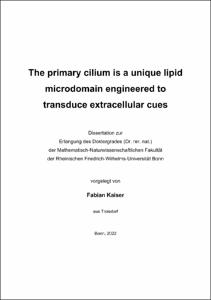The primary cilium is a unique lipid microdomain engineered to transduce extracellular cues

The primary cilium is a unique lipid microdomain engineered to transduce extracellular cues

| dc.contributor.advisor | Wachten, Dagmar | |
| dc.contributor.author | Kaiser, Fabian | |
| dc.date.accessioned | 2022-04-06T06:57:25Z | |
| dc.date.available | 2023-04-15T22:00:23Z | |
| dc.date.issued | 06.04.2022 | |
| dc.identifier.uri | https://hdl.handle.net/20.500.11811/9731 | |
| dc.description.abstract | Cilia are membrane protrusions located at the surface of almost every vertebrate cell. Cilia come in two different flavors: motile cilia, which generate a fluid flow or propel cells for active movement, and immotile, also called primary cilia. Primary cilia are considered as cellular antennae that receive extracellular signals and transduce them into a cellular response. Primary cilia dysfunction has been linked to severe human diseases, collectively termed ciliopathies. However, the underlying molecular mechanisms are not well understood. The Hedgehog (Hh) pathway is the predominantly studied pathway in primary cilia. It signals via G protein-coupled receptors (GPCRs) to control ciliary cyclic adenosine monophosphate (cAMP) levels and, thereby, the transcription of Hh target genes. Dysregulation of the Hh signaling has been proposed to underlie the development of ciliopathies and human cancer. Subcellular signaling is crucially determined by the local lipid environment. The lipid identity of the primary cilium determines ciliary signaling and seems to be disturbed under pathophysiological conditions. However, the ciliary lipid domain architecture, its regulation, and how it controls ciliary signaling remains elusive. To delineate the lipid composition, I established a method to isolate and enrich the primary cilia membrane (CM) followed by mass spectrometric analysis. My results demonstrate that the CM is enriched in glycosphingolipids (GSLs), which determine the biophysical properties of the membrane. In turn, the ciliary localization of Hh signaling components is altered, i.e., the localization of ciliary GPCRs. To analyze downstream signaling, I established fluorescent cAMP biosensors to measure cAMP dynamics in the primary cilium and, thereby, unravel the molecular mechanisms underlying ciliary cAMP signaling under physiological and pathological conditions. | en |
| dc.language.iso | eng | |
| dc.rights | Namensnennung 4.0 International | |
| dc.rights.uri | http://creativecommons.org/licenses/by/4.0/ | |
| dc.subject | Primäres Zilium | |
| dc.subject | Membranordnung | |
| dc.subject | Lipidomics | |
| dc.subject | Fluoreszenzmikroskopie | |
| dc.subject | RT-qPCR | |
| dc.subject | Hedgehog Signalweg | |
| dc.subject | Lipid Homeostase | |
| dc.subject | Optogenetik | |
| dc.subject | primary cilium | |
| dc.subject | membrane order | |
| dc.subject | environment-sensitive dyes | |
| dc.subject | lipidomics | |
| dc.subject | fluorescence microscopy | |
| dc.subject | lipid homeostasis | |
| dc.subject | optogenetics | |
| dc.subject.ddc | 570 Biowissenschaften, Biologie | |
| dc.title | The primary cilium is a unique lipid microdomain engineered to transduce extracellular cues | |
| dc.type | Dissertation oder Habilitation | |
| dc.publisher.name | Universitäts- und Landesbibliothek Bonn | |
| dc.publisher.location | Bonn | |
| dc.rights.accessRights | openAccess | |
| dc.identifier.urn | https://nbn-resolving.org/urn:nbn:de:hbz:5-65857 | |
| dc.relation.doi | https://doi.org/10.1042/BST20190246 | |
| dc.relation.doi | https://doi.org/10.7554/eLife.57907 | |
| dc.relation.doi | https://doi.org/10.1002/1873-3468.13816 | |
| ulbbn.pubtype | Erstveröffentlichung | |
| ulbbnediss.affiliation.name | Rheinische Friedrich-Wilhelms-Universität Bonn | |
| ulbbnediss.affiliation.location | Bonn | |
| ulbbnediss.thesis.level | Dissertation | |
| ulbbnediss.dissID | 6585 | |
| ulbbnediss.date.accepted | 03.03.2022 | |
| ulbbnediss.institute | Medizinische Fakultät / Institute : Institut für Angeborene Immunität | |
| ulbbnediss.fakultaet | Mathematisch-Naturwissenschaftliche Fakultät | |
| dc.contributor.coReferee | Thiele, Christoph | |
| ulbbnediss.contributor.orcid | https://orcid.org/0000-0003-4451-6079 | |
| ulbbnediss.date.embargoEndDate | 15.04.2023 | |
| ulbbnediss.contributor.gnd | 1270461907 |
Files in this item
This item appears in the following Collection(s)
-
E-Dissertationen (4337)




